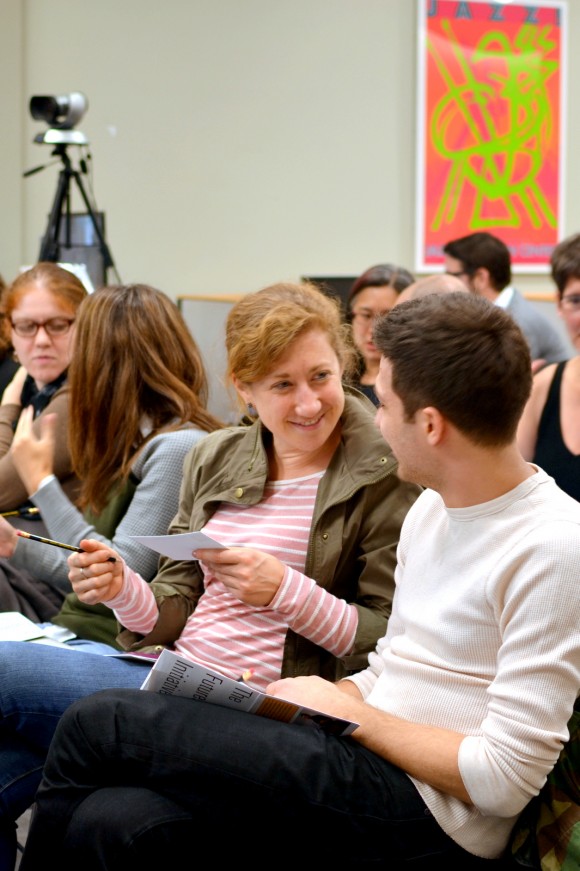By Cathy Davidson
Cross-posted to the Futures Initiative HASTAC Group.

Think-Pair-Share activity during our What is a Dissertation event. Photo: Lisa Tagliaferri
Here are a baker’s dozen of the main principles of connected learning. As you will see, they form an “ecosystem,” where each component influences and changes the others. These apply in any field (although differently in each field). These principles draw from constructivist, engaged “public educators” (Stuart Hall’s term) going back as far as Lev Vygotsky and John Dewey and including Howard Gardner, Franz Fanon, Jacques Rancière, and digital pedagogy theorists including Yochai Benkler, Howard Rhinegold, Mizuko Ito, and many others.
The truly remarkable extra authority we’ll be adding to the mix in our “Mapping the Futures of Higher Education” course is we will be co-learning with the former President of the Graduate Center CUNY, Bill Kelly. To have real-world insights into higher education to set next to theories and principles and classroom practices is the real game changer. Stay tuned! We’ll be offering several open sessions of our course so that anyone who wishes can contribute and participate.
- Learning is teaching. We know from extensive research across many fields that the single most successful way to learn is to teach someone else. In medical school, this is called “See one. Do one. Teach one.” And we have added “Share One” since there is a digital, public component of this course.
- Learning is research and research is learning. That isthe project, in the purest form, of this remarkable place known as the Graduate Center. The GC structure is such that current students immersed in their own specialized research turn outward to teach some 200,000 undergraduate students in the CUNY campuses every year. That is inspiring! The structure of this course (and the Futures Initiative) fully embodies the unique research mission of this public institution.
- Learning is institutional and socially-engaged learning changes institutions. What is the relationship between mastering a discipline–and changing it? How does knowledge evolve? How do fields? How do institutions? (To have this course co-taught by both a newcomer to CUNY and the third President of the GC is a very rare confluence and opportunity for addressing institutional change on a deep and practical level.)
- Learning together is key—in class, in study groups, online. But successful collaboration is not born; it is carefully nurtured, constructed, challenged, assessed, revised, and designed.
- Learning is a formative test–not a high stakes summative one. An ideal way to learn (this is the basis of “adaptive learning”) is for challenges to be built into the learning process in a way that helps the student understand what s/he knows, what s/he is missing, and offers an individualized pathway to mastery.
- Learning makes a public contribution to knowledge. It makes no sense to substitute a blog for a term paper if there is no real change in audience, outcome, and purpose.
- Learning in public requires digital and data literacies, being aware of how, why, and by whom one’s knowledge is being used.
- Learning is a social activity and social responsibility (we will be connecting your learning to real world outcomes, examples, and experiences).
- Learning is interest-driven–and even fun. How we have adopted the “Gradgrind” idea that learning needs to be enforced and school a source of misery?
- Learning opportunities are everywhere; the city is a classroom; everyone and everything is a resource. How do we start thinking of our class as a learning community and a learning resource?
- Learning is vocational–in a good way. Nobel Prize winning economist Amartya Sen has argued that all education should be vocational–and the vocation is leading a good, productive, socially responsible and even happy life.
- Learning is about access, equity, and equality. There is a powerful explicit and implicit social justice component to all engaged, connected learning.
- Learning is sustainable… if it keeps these principles and practices in mind. I’ve heard it described as “cradle to cradle” learning. Keeping on, keeping on!

